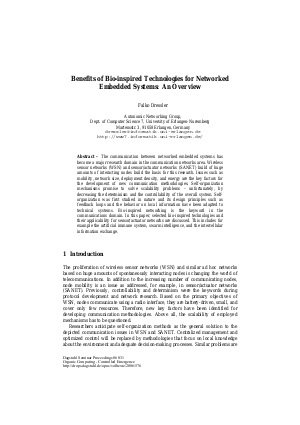Benefits of Bio-inspired Technologies for Networked Embedded Systems: An Overview
Author Falko Dressler
-
Part of:
Volume:
Dagstuhl Seminar Proceedings, Volume 6031
Part of: Series: Dagstuhl Seminar Proceedings (DagSemProc) - License:
 Creative Commons Attribution 4.0 International license
Creative Commons Attribution 4.0 International license
- Publication Date: 2006-05-16
File

PDF
DagSemProc.06031.3.pdf
- Filesize: 369 kB
- 10 pages
Document Identifiers
Subject Classification
Keywords
- Bio-inspired networking
- self-organization
- wireless sensor network
- sensor/actuator network
Metrics
- Access Statistics
-
Total Accesses (updated on a weekly basis)
0Document
0Metadata
Abstract
The communication between networked embedded systems has become a major research domain in the communication networks area. Wireless sensor networks (WSN) and sensor/actuator networks (SANET) build of huge amounts of interacting nodes build the basis for this research. Issues such as mobility, network size, deployment density, and energy are the key factors for the development of new communication methodologies. Self-organization mechanisms promise to solve scalability problems – unfortunately, by decreasing the determinism and the controllability of the overall system. Self-Organization was first studied in nature and its design principles such as feedback loops and the behavior on local information have been adapted to technical systems. Bio-inspired networking is the keyword in the communications domain. In this paper, selected bio-inspired technologies and their applicability for sensor/actuator networks are discussed. This includes for example the artificial immune system, swarm intelligence, and the intercellular information exchange.
Cite As Get BibTex
Falko Dressler. Benefits of Bio-inspired Technologies for Networked Embedded Systems: An Overview. In Organic Computing - Controlled Emergence. Dagstuhl Seminar Proceedings, Volume 6031, pp. 1-10, Schloss Dagstuhl – Leibniz-Zentrum für Informatik (2006)
https://doi.org/10.4230/DagSemProc.06031.3
BibTex
@InProceedings{dressler:DagSemProc.06031.3,
author = {Dressler, Falko},
title = {{Benefits of Bio-inspired Technologies for Networked Embedded Systems: An Overview}},
booktitle = {Organic Computing - Controlled Emergence},
pages = {1--10},
series = {Dagstuhl Seminar Proceedings (DagSemProc)},
ISSN = {1862-4405},
year = {2006},
volume = {6031},
editor = {Kirstie Bellman and Peter Hofmann and Christian M\"{u}ller-Schloer and Hartmut Schmeck and Rolf W\"{u}rtz},
publisher = {Schloss Dagstuhl -- Leibniz-Zentrum f{\"u}r Informatik},
address = {Dagstuhl, Germany},
URL = {https://drops.dagstuhl.de/entities/document/10.4230/DagSemProc.06031.3},
URN = {urn:nbn:de:0030-drops-5761},
doi = {10.4230/DagSemProc.06031.3},
annote = {Keywords: Bio-inspired networking, self-organization, wireless sensor network, sensor/actuator network}
}
